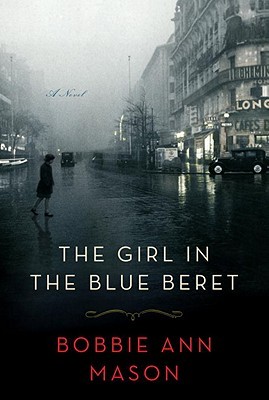I have long been a fan of Bobbie Ann Mason, whose fiction I discovered in the ’80s when I was a perpetually exhausted teacher. Reading was my weekend rehab, and after devouring one of Mason’s early stories in The Atlantic, I rushed from bookstore to bookstore to bookstore (it took three!) to find a copy of her first book, Shiloh and Other Stories, winner of the PEN/Hemingway Award. She has an elegant, simple style, and skillfully captures the voices of smart working-class and lower-middle-class characters who mostly live in her native Kentucky.
The Girl in the Blue Beret, published in 2011, is a beautifully-written novel that reflects her empathy for war veterans suffering from post-traumatic stress disorder. It is not set in Kentucky: based on her father-in-law’s World War II experiences, it is the story of Marshall Stone, a recently retired airline pilot and widower who has been too absorbed by his family and job–he loves flying– to think about the crash of his B-17 bomber in Belgium and the members of the Resistance who saved his life. Before he retired, on his last flight as a pilot to Europe, he visited the crash site. Angry that he has been forced out of a job and at loose ends in his house in New Jersey, he invites his unemployed son to housesit while he goes to Paris to search for the members of the Resistance who risked their lives to save him from the Nazis after the plane crash.
Mason cleverly interweaves the past with the present: Marshall in his sixties shares many of the regrets of Marshall as a cocky young Air Force pilot in England, going on bombing missions. Young Marshall was frustrated to be discharged after his ordeal in France; he wanted to continue bombing the Nazis. The Marshall of the present feels cheated that he has been forcibly retired only because of age.
Robert theoretically knew the Resistance took risks to help allied pilots like himself. Still, he has never quite understood it. Marshall is shocked to learn that a man named Robert had became somehow fractured after the war: he even had two families, one with his wife and one with his mistress. Robert’s estranged daughter (by the mistress) tells him about Robert’s gradual descent into alcoholism and mental illness. Marshall cannot imagine what happened. (Later we learn.)
The image that has always stayed with him over the years is that of the girl in the blue beret, a lively, confident teenage girl who who guided him through Paris. Her family sheltered him in their apartment until it was safe to leave. Eventually he left France through the Pyrenees.
Mason has a gift for creating lively, natural dialogue. Annette’s Nazi ballerina image make me laugh.
He remembered her laughing. She was standing by the window, half hidden by the lace curtain, with springy spools of brown hair dangling beside her cheeks. She said, “Don’t look, but there are two German officers down there. Their uniforms are so silly! They look like ballerinas in those big pleated coats. Oh, I can’t say this, it’s too embarrassing, but they were walking where the neighbor’s dog was walking and one of them–oh, his boots!” She laughed. “They deserve that!”
His reunion with Annette, a widowed farmer, is especially moving. She is still sparkling, with a sense of humor, even though she has suffered. The war was terrible for Annette’s family. Her story is shattering. Yet she and Marshall help each other find peace. .
Part of what I love about this book is Mason’s description of Paris. I have never been a Francophile, but now I want to go to Paris. I want to walk miles around the city and sip aperitifs and eat langoustines at a posh restaurant. (At a restaurant, Robert’s daughter suggests they order langoustines).
“Sure,” he said, wondering–and not caring–if langoustines might be pig snouts, or some obscure organ meats. They were the most expensive item.
Like Robert, I had never heard of langoustines. They are small lobster claws.
At times I am slightly reminded of her 1986 novel, In Country, a story of the long-term consequences of the Vietnam War on a family in Kentucky. This is a different war, of course:
Mason did a vast amount of research. The character Annette is based partly on Michele Moet-Agniel, an escort for Allied airmen shot down in Occupied Europe who saved Mason’s father-in-law. Mason also read the diary of Virginia d’Albert Lake, a survivor of the slave-labor camp in Occupied Poland.
A very moving book: I loved it!



I haven’t read anything by Mason in decades and hadn’t heard of this one until now. I’m adding it to my list. So far this year I’ve read two on your recommendation: The Weather in the Streets and The Waterfall. You’re batting a thousand!
LikeLike
Liz, I almost missed this one, too. There are so many great books, and it’s wonderful to be able to share them at blogs! Glad you’ve enjoyed some of my faves.
LikeLike
Lovely review Kat and I’m impressed by the sound of Mason’s work. She’s an author I confess I hadn’t even heard of so it’s always nice to get a recommendation of a new writer to read. I’ll look out for her!
LikeLike
Perhaps she’s more famous in the U.S.! The Kentucky thing: you know. She’s very good: I almost missed this book myself/
LikeLiked by 1 person
Not a writer I know but I may well look out for this book at least. I am in the middle of a module on post traumatic stress in literature and last week my book group had a long discussion on just to what extent Hemingway was suffering from PTMS after his experiences in the first world war. It doesn’t necessarily excuse his behaviour towards his wives but it might go some way towards explaining it.
LikeLike
Mason is good on PTSD. I was very impressed with this. Sounds like a fascinating module, and I always love the sound of your books groups. Her book “In Country” is also excellent, and was made into movie with Bruce Willis as a Vietnam vet suffering from the effects of Agent Orange. It’s been a while, but I thought the movie was good, too.
LikeLike